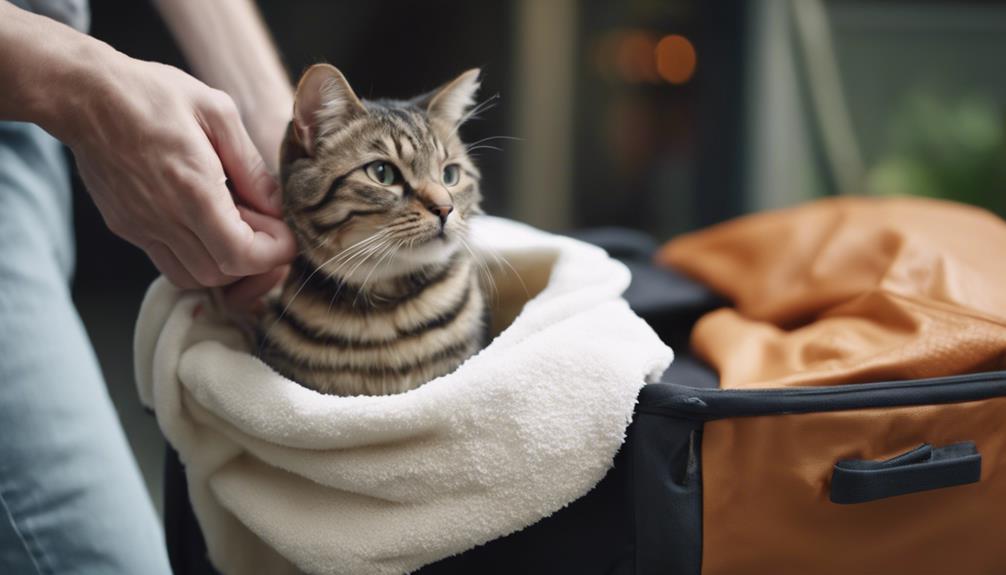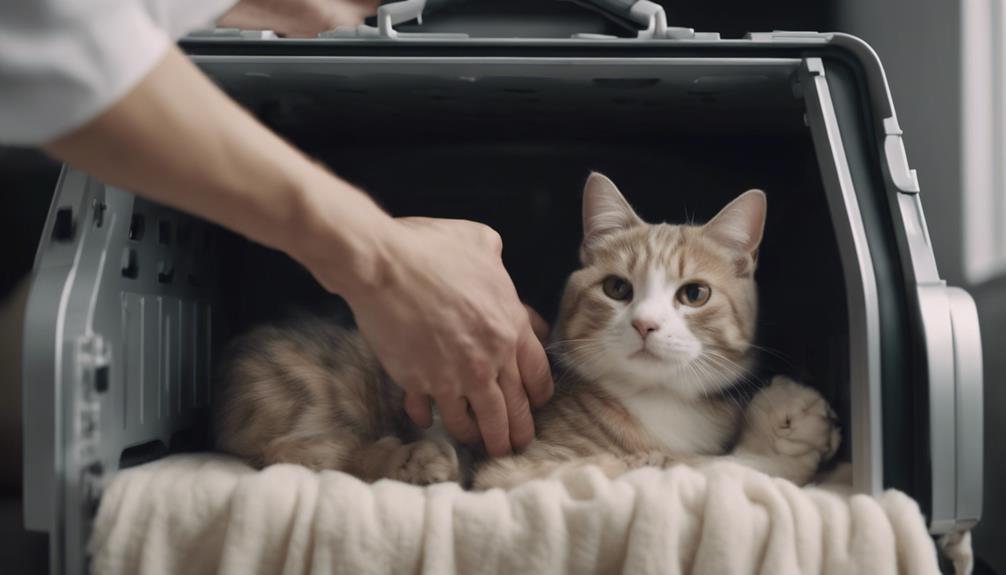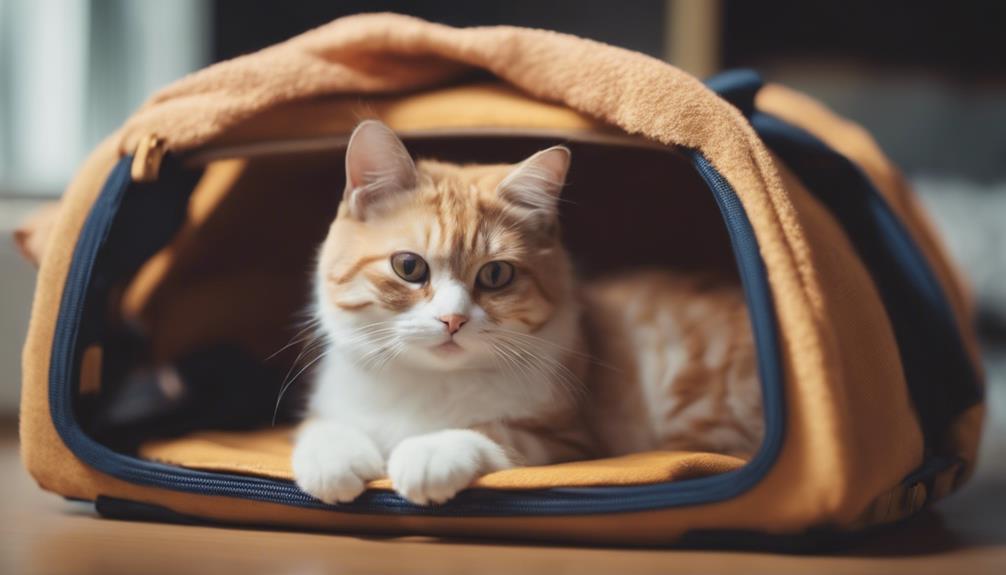Transporting a cat in a carrier can be a daunting task for many pet owners, often resulting in stress for both the feline and its human counterpart. However, with the guidance of professionals in the field, there are proven strategies and techniques that can make this process smoother and more manageable.
By implementing expert tips and recommendations, pet owners can navigate this challenge with greater ease and confidence.
Stay tuned to discover the secrets to successfully coaxing your cat into a carrier, ensuring a harmonious and stress-free experience for all involved.
Key Takeaways
- Familiarize your cat with the carrier gradually using treats and familiar bedding.
- Decide on entering head or bum first, secure your cat confidently with both hands.
- Ensure your cat's safety by using a well-constructed carrier and securing them in the car.
- Consider using calming aids and Feliway spray for added calmness during the process.
Preparation for Cat Carrier Training
To effectively prepare for cat carrier training, one must prioritize gradual familiarization with the carrier and the use of positive reinforcement techniques. Begin by introducing the carrier in a non-threatening environment, allowing the cat to explore at its own pace.
Incorporate enticing treats and familiar bedding inside the carrier to create positive associations. Keep the carrier accessible for frequent interactions, encouraging the cat to view it as a safe space. Utilizing calming pheromones can also aid in reducing anxiety around the carrier.
Building Positive Carrier Associations
When preparing your cat for carrier training, establishing positive associations with the carrier is essential for ensuring a stress-free experience.
Begin by placing the carrier in areas where your cat frequents, allowing them to explore it at their own pace.
Introduce treats or toys inside the carrier to create a positive connection. Encourage your cat to nap or relax in the carrier with familiar bedding to make it a comfortable space.
Utilize calming pheromones to enhance relaxation and reduce anxiety associated with the carrier.
Techniques for Smooth Cat Entry

How can cat owners facilitate a smooth and stress-free process when it comes to getting their feline companions into a carrier? One effective method is to approach the task with confidence and patience, ensuring the cat feels secure throughout the process. Below is a table outlining techniques for smooth cat entry:
| Techniques for Smooth Cat Entry | Description | Benefits |
|---|---|---|
| Enter Head or Bum First | Choose the most comfortable | Helps cat feel at ease |
| Confident and Smooth Movement | Avoid sudden movements | Reduces stress and anxiety |
| Use Calming Aids | Consider pheromone sprays | Promotes relaxation |
| Secure with Both Hands | Ensure safety during entry | Prevents escape or injuries |
Ensuring Cat Comfort in Carrier
Facilitating a stress-free experience for cats when being placed in a carrier involves prioritizing their comfort and security throughout the process.
Placing familiar bedding inside the carrier can offer a sense of familiarity and comfort to your feline companion. Additionally, using calming aids such as pheromone sprays or treats can help reduce anxiety and create a more soothing environment.
Ensuring that the carrier is well-ventilated and spacious enough for your cat to move comfortably can also contribute to their overall comfort.
Safety Measures During Transport

Ensuring the safe transport of your cat involves adhering to recommended safety measures to protect your feline companion during travel. When transporting your cat in a carrier, it is essential to prioritize their safety and well-being.
Secure your cat in the car using seat belts or other appropriate restraints, ensuring they are as safe as you are during the journey. Opt for carriers that allow your cat to move comfortably, providing ventilation and space for them to stretch and adjust their position.
Each cat should have its carrier to prevent stress and potential conflicts during travel. Choose a well-constructed carrier, considering crash-test certified options for added safety measures. By implementing these precautions, you can ensure a secure and stress-free travel experience for your beloved feline friend.
Best Practices for Cat Carrier Use
What are the key strategies for optimizing the use of cat carriers to ensure safe and stress-free transportation for your feline companion?
- Choose the right size: Select a carrier that allows your cat to stand up, turn around, and lie down comfortably to reduce stress during travel.
- Familiarize your cat: Encourage positive associations by leaving the carrier open in your home with treats and familiar bedding inside, making it a cozy and inviting space.
- Practice makes perfect: Regularly acclimate your cat to the carrier by taking short trips or simply letting them relax in it at home, helping them associate the carrier with comfort and security.
Enhancing Cat Carrier Experience

Enhancing the cat carrier experience involves optimizing comfort and security for feline transportation.
To enhance this experience, consider adding familiar items like a favorite blanket or toy inside the carrier to provide a sense of home during travel. Additionally, using calming aids such as pheromone sprays or treats can help reduce anxiety and make the carrier a more inviting space.
Ensuring proper ventilation and a comfortable bedding arrangement will further enhance your cat's comfort during transportation.
Continuous Improvement in Cat Care Services
To drive continual enhancements in cat care services, a strategic approach involving feedback analysis, technological integration, staff training, market research, and collaborative initiatives is imperative.
- Feedback Analysis: Regularly gather feedback from customers to understand their needs and preferences, allowing for targeted improvements.
- Technological Integration: Implement new technologies such as automated feeding systems or remote monitoring tools to enhance the level of care provided.
- Staff Training: Invest in ongoing training for staff members to ensure they are equipped with the latest knowledge and skills to deliver top-notch cat care services.
Conclusion
In conclusion, mastering the art of getting your cat into a carrier requires patience, strategy, and a comprehensive approach. By following expert tips and techniques, you can ensure a smoother and less stressful experience for both you and your feline companion.
Building positive associations with the carrier, using calming aids, and practicing secure handling are key elements in successful cat carrier training. Continuous improvement and dedication to cat care services will ultimately enhance the overall experience for both you and your beloved pet.




